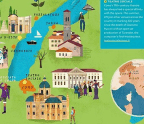

ALENTEJO
LAKE OF STARS
The world’s first Starlight Tourism Destination, Portugal’s Alqueva region offers round-the-clock adventure — from dawn flights by hot air balloon to a kayaking tour under a dazzling night sky.
Words: Orla Thomas
In Alqueva, rush hour kicks off at 9.30pm. The area’s roads remain as empty at night as they are by day, but 340 miles above, a queue of Starlink satellites is starting to form. “There’s the International Space Station,” says astronomer Nuno Santos, directing his green laser pointer south. “Give the three people on board a wave!”
After a few more minutes, my eyes have adjusted to the utter blackness over the Dark Sky Alqueva Observatory, allowing more celestial bodies to appear. First startlingly luminous Venus, then an orange-hued Mars. The backdrop to these scene-stealing planets is an incomprehensible number of stars, twinkling like a handful of glitter tossed into the night sky.
To orientate myself, I search for the most famous of the animal constellations: Ursa Major. “Can’t see the shape of a great bear?” says Nuno. “Don’t worry, me neither. Remember, the people who named them drank really good wine.”
Mastery of the stars was the making of Portugal. The country dominated the Age of Discovery in the 15th and 16th centuries, when European nations began exploring the world by sea. I’ve been using GPS to find my way around the Alqueva Dark Sky Route — aroad trip stitching together stargazing spots, accommodation and activities — but for early navigators the equivalent was the North Star. “The light we see from it now was cast when the astronomer Galileo was still alive,” Nuno tells the small group attending one of his nightly sessions. “Look at the night sky, and you’re looking at the past.”
Wind the clock back only a few decades, and Alqueva would’ve looked very different. Today, it’s dominated by the Alqueva Reservoir, Europe’s largest artificial body of water. Completed in 2002, work on it didn’t begin until 1995, despite plans being mooted as far back as the 1950s. The brainchild of António de Oliveira Salazar, prime minister of Portugal between 1932 and 1968, it was intended to irrigate this largely agricultural region, nicknamed ‘Portugal’s breadbasket’ for its abundance of cereal crops. The area receives a fraction of the visitors its neighbour, the Algarve, gets, despite the addition of a lakeshore longer than the entire Portuguese coast.
From the fortified hilltop settlement of Monsaraz, it’s possible to get a sense of the Alqueva Reservoir’s scale. Standing on the ramparts of its castle, I can see how damming the Guadiana River filled Alentejo’s once-arid valleys and made islands out of hilltops. Around the lake, the region looks much as it always has: rolling fields of wheat and vines, plus a smattering of cork and olive trees.
A hot air balloon offers an even better view. Setting out on a dawn flight with adventure company Emotion, a roar of liquid propane from the canister overhead signals our departure. I imagine this is what it’s like to travel inside the mouth of a dragon. Soon a blast of wind sends our craft skyward, where the silence becomes almost eerie. After brushing the treetops with our basket, we’re over the Alqueva Reservoir — still enough today to offer a reflection. Our yellow balloon gleams like a giant light-bulb on the water’s surface, until the mirror effect is disturbed by a fish leaping in the shallows.
Somewhere beneath, says pilot Carlos Sousa, is the lost village of Aldeia da Luz. A latter-day Atlantis, the settlement was evacuated in 2002 and its remains flooded during the creation of the Alqueva Reservoir. Most of its residents moved — reluctantly — to a replica village, built nearby on higher land. “It was very hard for them,” says Carlos. “In Portugal, we’re very attached to tradition. Some people even took their windows and doors with them.”




Soon our flight passes over the village’s new iteration, its white-and-yellow houses Lego-like, its cemetery ordered and pristine (it too was relocated from the original site). On the horizon beyond is Mourão, one of five small towns bordering the reservoir. With an aerial perspective, I can see the battlements of its medieval castle






